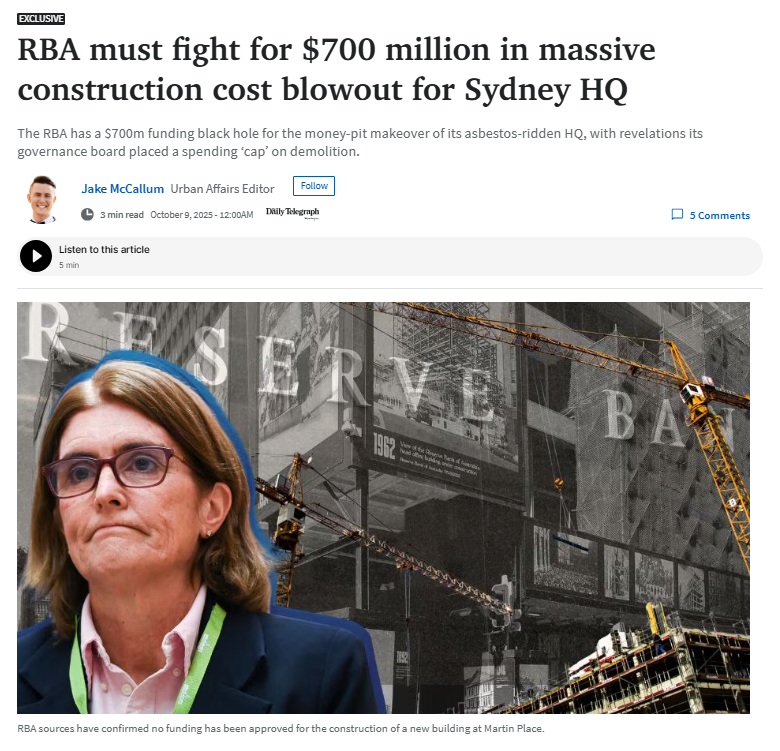Media
|
News
October 9, 2025

The Reserve Bank of Australia has a $700 million funding black hole for the money-pit makeover of its asbestos-ridden HQ, with revelations that the bank’s governance board placed a spending ‘cap’ of $533.6 million on renovations, now expected to cost more than $1.2 billion.
The RBA will have to fight for and prove the value of $700 million in funds to bridge the gap between the $533 million approved by the board for the demolition works and the blowout to construction costs for its Martin Place offices in the Sydney CBD.
The amount approved by the federal bank was for “asbestos removal only, not funding to redevelop to site” according to RBA sources, speaking confidentially to The Daily Telegraph.
“The new RBA governance board is watching the costs closely,” the source said.
“And there needs to be a gate that has to be opened every time the construction cost increases.
“They are watching to ensure the project is cost-effective, and can veto any expenditure if it goes over the amount approved.”
The project will be forced through several governance review stages, which will re-evaluate the merits of the project, with the next set to be conducted at the end of the asbestos removal phase.
RBA sources confirmed no funding has been approved for the construction of a new building at Martin Place, or the fit out of workspaces, as RBA Governor Michele Bullock conceding last months she had “low confidence” construction costs wouldn’t surpass the $1.2 billion forecasts.
Revelations of the funding black hole come as development documents confirmed the RBA had the option to permanently relocate and sell the building at 65 Martin Place – after construction workers discovered “unacceptably high level of hazardous material” – and before the cost to taxpayers exploded.
But instead of ditching its former home for new, cheaper digs, the RBA decided to undertake the expensive challenge of attempting several almost impossible tasks, including the removal of some of the facade of the building to “salvage of heritage significant” items, the protection of the internal structure and removal of “Hazmat consisting of bonded low risk and friable high risk” materials.
The option to demolish the site was also canvased by federal bank officials, however, the Telegraph understands there are two heritage listings at a Commonwealth and local government level on the site, as well as a “Martin Place special character” restriction on the site, meaning the RBA did not have “free reign to knock the building down”.
The project is now internally seen no longer a renovation, but a rebuild, after asbestos was found in “all structural elements on all floors”, including the “underside of concrete slabs, beams, columns and the facade”.
“We did assess the option of relocating, as well as a complete knock down, but the bank realised it has to pay 30 years of rent in the Sydney market and rebuilding, unfortunately, it is still the most cost effective option,” an RBA source said.
“The building value went to zero and the only way is up.”
However, the RBA won’t have to go cap-in-hand to the Federal Government for funding, as the federal bank is “self-funded” with oversight from various review panels inside federal parliament.
Instead, it will have to fund the redevelopment through its internal revenue streams.
But the $700 million funding black hole still comes at a hit to the public coffers, with the RBA’s profits paid to the Commonwealth Government as a revenue for the Federal Budget each year.
The reserve bank did not pay a dividend to the federal government in 2024, 2023 or 2022 as a result of accounting losses.
Shadow finance spokesman James Patterson questioned the RBA governance board’s decision to forge ahead with the redevelopment.
“No one should understand the concept of a sunk-cost better than the Reserve Bank,” he said.
“Property development is not the core expertise of any central bank.
“This project has been a disaster every step of the way, and the governor has publicly admitted further blowouts - already totalling $1 billion - are likely.
“The governance board must seriously examine every plausible alternative, including the option they dismissed in 2019 of building a new building elsewhere in Sydney for less than half the current proposed cost.”
A similar cash blowout is currently underway in the United States, with President Donald Trump smashing the Federal Reserve Bank over a $2.5 billion construction blowout in Washington DC.